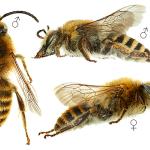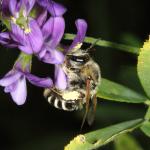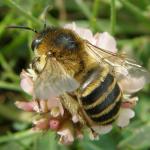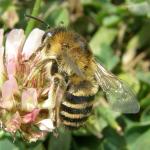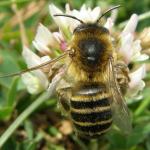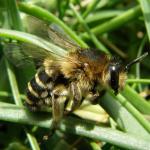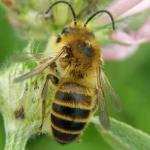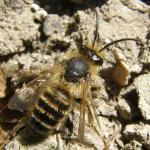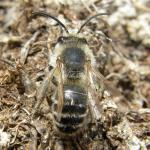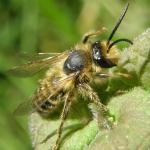Andrena fortipes IMHOFF 1832; Cilissa ruthenica RADOSZKOWSKI 1891; Melitta centaureae TORKA 1922
This species is very closely related to M. tricincta and care is necessary to distinguish the two in collections. However, in the field, each species is usually readily identified by the flowers the bees visit. In addition, the present species is more widely distributed in Britain than its congener, being found in northern and western localities from which the other is absent.
Widely distributed in southern England, becoming scarce in the northern counties and in Wales (in which country it may be under-recorded). It also occurs on the Isles of Scilly and in the Channel Islands (Alderney and Jersey). There are no records from Scotland or Ireland. Distributed throughout Europe from Fennoscandia south to Iberia, and east to Turkey and Ukraine (Warncke, 1973).
Not listed in Shirt (1987) or Falk (1991). Work for this Atlas suggests that its status should be reviewed.
Open grassland on sand, chalk and clay soils. Sometimes found in gardens.
Univoltine; late June to August.
Nesting burrows are excavated in the soil. In a garden at Harefield, Middlesex, nest burrows occurred in a small, loose aggregation of about nine nests in approximately 5.5 m2 of lawn; the burrow entrances were well concealed amongst the grass blades (C R Vardy, pers. comm.). At Porth Oer, Caernarvonshire, a large nest aggregation was encountered in a coastal cliff. This aggregation was estimated to occupy an area approximately 5 m by 2 m on both level and steeply inclined, sparsely vegetated soil. There were at least 20 nest burrows per m2 (M Edwards, pers. comm.). On St. Mary's, Isles of Scilly, the late G M Spooner (pers. comm.) found many females burrowing into the soil on a cliff ledge. The nesting habits have been described by Malyshev (1923) and the prepupa and pupa have been described and figured by Rozen & McGinley (1974).
The bee has a marked preference for white clover (Trifolium repens), but also visits lucerne (Medicago sativa), melilot (Melilotus sp.), hare's-foot clover (Trifolium arvense), bird's-foot-trefoil (Lotus corniculatus), bramble (Rubus fruticosus agg.), saw-wort (Serratula tinctoria), musk thistle (Carduus nutans), and dandelion (Taraxacum sp.). Males have been observed roosting in compact groups in the flower heads of yarrow (Achillea millefolium)(Yarrow, 1940).
Nomada flavopicta is probably a cleptoparasite of this species (Yarrow, 1941; Tengö & Bergstrom, 1976). This Nomada has also been seen inspecting known burrows of M. leporina in Harefield (C R Vardy, pers. comm.) and at Porth Oer (M Edwards, pers. comm.).
Profile written: 1998
Proofed: January 2012


